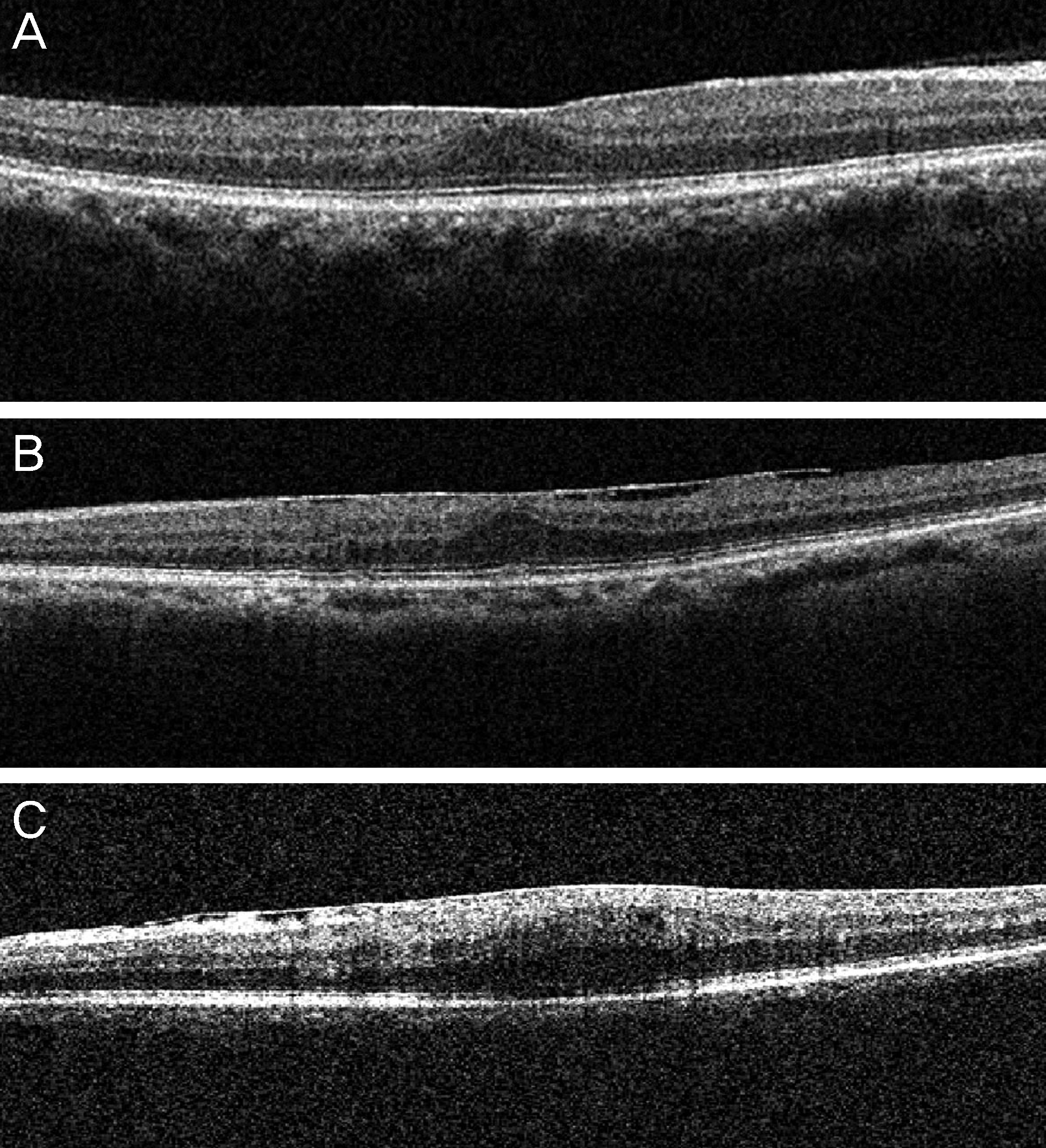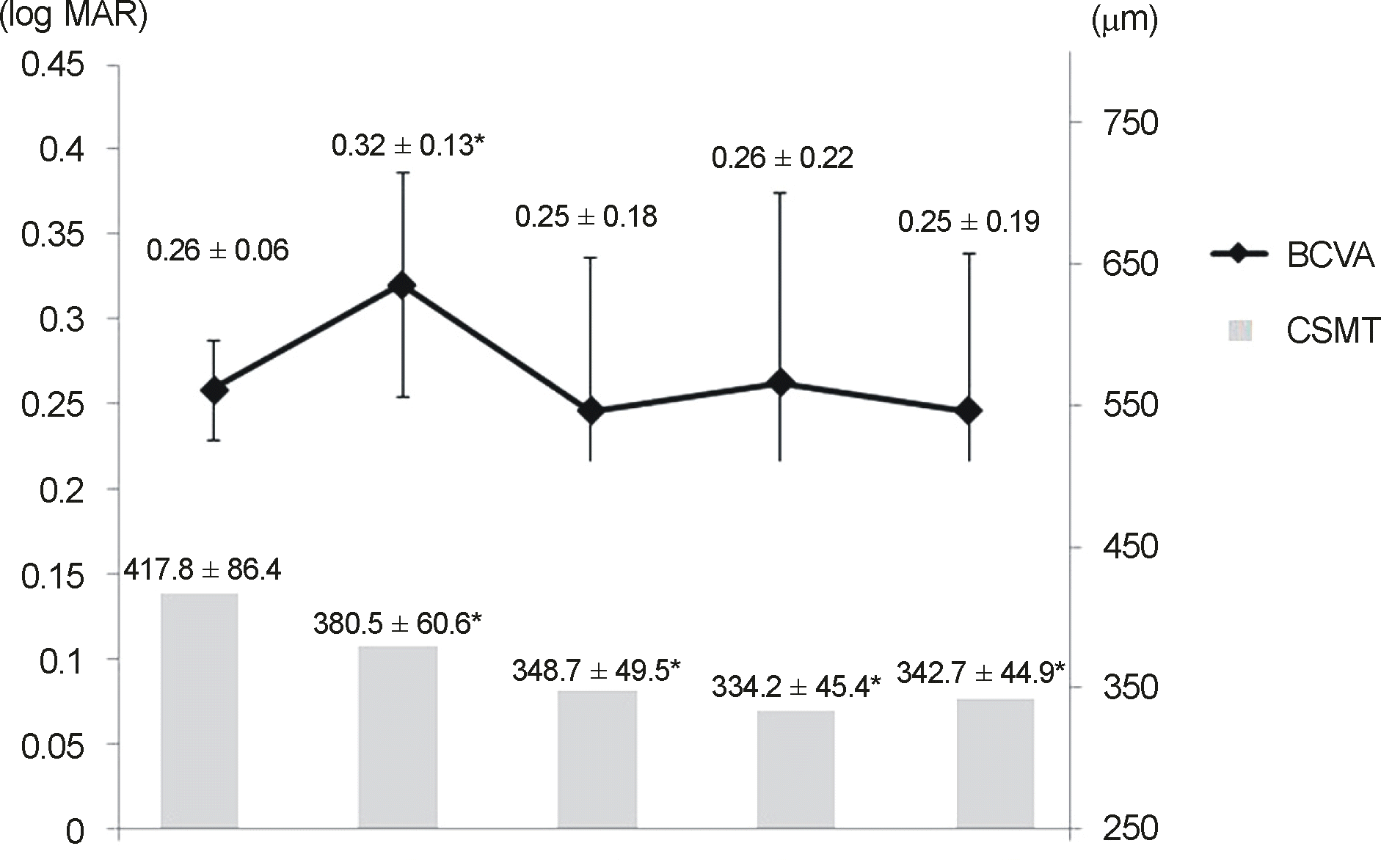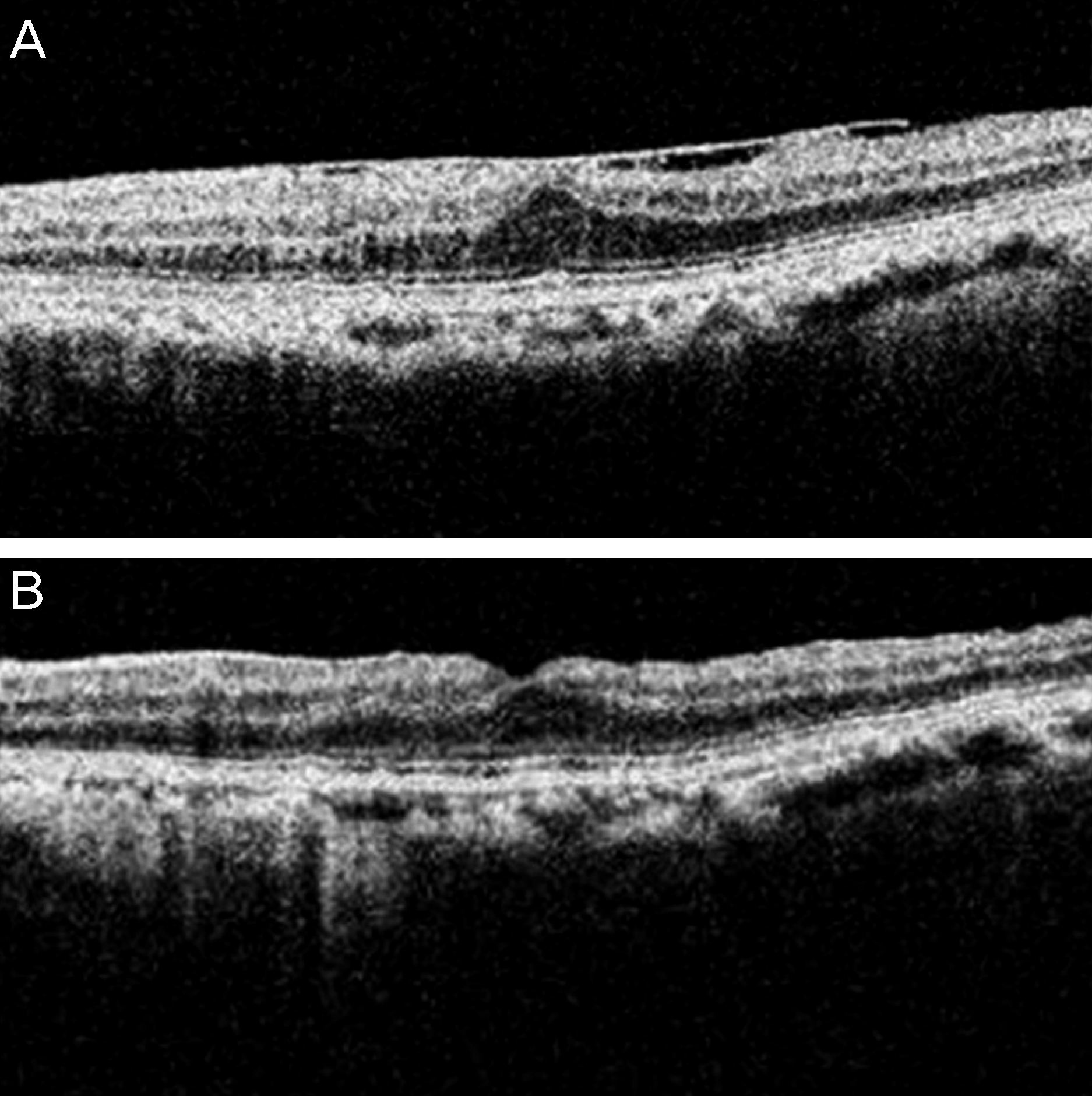Abstract
Purpose
To evaluate surgical outcomes of idiopathic epiretinal membrane (ERM) with good visual acuity.
Methods
We evaluated patients who were diagnosed with idiopathic ERM with best corrected visual acuity (BCVA) greater than 20/40 and who were followed-up for 12 months or longer after vitrectomy and membrane removal. BCVA, metamorphopsia, central subfield macular thickness (CSMT), foveal contour, and status of photoreceptor inner/outer segment (IS/OS) junction were retrospectively assessed based on the medical records and optical coherence tomography (OCT) images.
Results
Twenty-four eyes were included in the present study. The mean BCVA (log MAR) did not significantly improve from baseline to 12 months after surgery (0.26 ± 0.06 and 0.25 ± 0.19, respectively). Six eyes showed improved vision of two or more lines, and six eyes had decreased vision of two or more lines. Metamorphopsia remained in all four eyes with preoperative symptoms until 12 months postoperatively. CSMT decreased significantly from 418 ± 86 pm at baseline to 343 ± 45 pm at 12 months (p < 0.01). Among 17 eyes without foveal depression at baseline, 11 eyes recovered a foveal depression at an average of 6.6 months after surgery. IS/OS status at baseline was intact in 19 eyes, attenuated in three eyes, and disrupted in two eyes and did not change significantly at 12 months.
Go to : 
References
1. Iwanoff A. Beiträge zur normalen und pathologischen Anatomie des Auges. Graefe's Arch Clin Exp Ophthalmol. 1865; 11:135–70.

2. Mitchell P, Smith W, Chey T, et al. Prevalence and associations of epiretinal membranes. The Blue Mountains Eye Study. Australia. Opthalmology. 1997; 104:1033–40.
3. Klein R, Klein BE, Wang Q, Moss SE. The epidemiology of epiretinal membranes. Trans Am Ophthalmol Soc. 1994; 92:403–25.
4. Fraser-Bell S, Guzowski M, Rochtchina E, et al. Five-year cumulative incidence and progression of epiretinal membranes: the Blue Mountains Eye Study. Ophthalmology. 2003; 110:34–40.
5. Poliner LS, Olk RJ, Grand MG, et al. Surgical management of premacular fibroplasia. Arch Ophthalmol. 1988; 106:761–5.

6. de Bustros S, Thompson JT, Michels RG, et al. Vitrectomy for idiopathic epiretinal membranes causing macular pucker. Br J Ophthalmol. 1988; 72:692–5.

7. de Bustros S, Rice TA, Michels RG, et al. Vitrectomy for macular pucker. Use after treatment of retinal tears or retinal detachment. Arch Ophthalmol. 1998; 106:758–60.
8. Pesin SR, Olk RJ, Grand MG, et al. Vitrectomy for premacular fibroplasias. Prognostic factors, long-term follow-up, and time course of visual improvement. Ophthalmology. 1991; 98:1109–14.
9. Wise GN. Clinical features of idiopathic preretinal macular fibrosis. Schoenberg Lecture. Am J Ophthalmol. 1975; 79:349–57.
10. Machemer R. The surgical removal of epiretinal macular membranes (macular puckers). Klin Monbl Augenheilkd. 1978; 173:36–42.
11. McDonald HR, Verre WP, Aaberg TM. Surgical management of idiopathic epiretinal membranes. Ophthalmology. 1986; 93:978–83.

12. de Bustros S, Thompson JT, Michels RG, et al. Nuclear sclerosis after vitrectomy for idiopathic epiretinal membranes. Am J Ophthalmol. 1988; 105:160–4.

13. Margherio RR, Cox MS Jr, Trese MT, et al. Removal of epimacular membranes. Ophthalmology. 1985; 92:1075–83.

14. Thompson JT. Epiretinal membrane removal in eyes with good visual acuities. Retina. 2005; 25:875–82.

15. Bentaleb-Machkour Z, Jouffroy E, Rabilloud M, et al. Comparison of central macular thickness measured by three OCT models and study of interoperator variability. Scientific World Journal. 2012; 2012:842795.

16. Shandiz JH, Derakhshan A, Daneshyar A, et al. Effect of cataract type and severity on visual acuity and contrast sensitivity. J Ophthalmic Vis Res. 2011; 6:26–31.
17. Kim J, Rhee KM, Woo SJ, et al. Long-term temporal changes of macular thickness and visual outcome after vitrectomy for idiopathic epiretinal membrane. Am J Ophthalmol. 2010; 150:701–9.

18. Çekiç Ö, Cakir M, Alagöz N, Yilmaz OF. Retinal thickness change in relation to visual acuity improvement after 23-gauge vitrectomy for idiopathic epimacular membrane. Eye (Lond). 2011; 25:180–4.

19. Falkner-Radler CI, Glittenberg C, Hagen S, et al. Spectral-domain optical coherence tomography for monitoring epiretinal membrane surgery. Ophthalmology. 2010; 117:798–805.

20. Lai CC, Wang NK, Wu WC, et al. The long-term anatomical and visual effect of intravitreal triamcinolone injection during vitrectomy for the treatment of idiopathic macular epiretinal membrane. Cutan Ocul Toxicol. 2011; 30:292–7.

21. Hwang DJ, Na KI, Kwon SI, Park IW. Long-term changes in visual acuity and foveal thickness after vitrectomy for idiopathic epiretinal membrane. J Korean Ophthalmol Soc. 2012; 53:434–9.

23. McDonald HR, Verre WP, Aaberg TM. Surgical management of idiopathic epiretinal membranes. Ophthalmology. 1986; 93:978–83.

24. Grewing R, Mester U. Results of surgery for epiretinal membranes and their recurrences. Br J Ophthalmol. 1996; 80:323–6.

25. Kwok AK, Lai TY, Li WW, et al. Indocyanine green-assisted internal limiting membraned removal in epiretinal membrane surgery: a clinical and histologic study. Am J Ophthalmol. 2004; 138:194–9.
26. Sorcinelli R. Surgical management of epiretinal membrane with indocyanine-green-assisted peeling. Ophthalmologica. 2003; 217:107–10.

27. Park DW, Dugel PU, Garda J, et al. Macular pucker removal with and without internal limiting membrane peeling: pilot study. Ophthalmology. 2003; 110:62–4.

28. Sivalingam A, Eagle RC Jr, Duker JS, et al. Visual prognosis correlated with the presence of internal-limiting membrane in histopathologic specimens obtained from epiretinal membrane surgery. Ophthalmology. 1990; 97:1549–52.
29. Chang S, Gregory-Roberts EM, Park S, et al. Double peeling during vitrectomy for macular pucker: the charles L. Schepens lecture. JAMA Ophthalmol. 2013; 131:525–30.
30. Haritoglou C, Gandorfer A, Gass CA, et al. The effect of indocyanine-green on functional outcome of macular pucker surgery. Am J Ophthalmol. 2003; 135:328–37.

31. Tsipursky MS, Heller MA, De Souza SA, et al. Comparative evaluation of no dye assistance, indocyanine green and triamcinolone acetonide for internal limiting membrane peeling during macular hole surgery. Retina. 2013; 33:1123–31.

32. Ej strup R, la Cour M, Heegaard S, Kiilgaard JF. Toxicity profiles of subretinal indocyanine green, Brilliant Blue G, and triamcinolone acetonide: a comparative study. Graefes Arch Clin Exp Ophthalmol. 2012; 250:669–77.

33. Watanabe K, Tsunoda K, Mizuno Y, et al. Outer retinal morphology and visual function in patients with idiopathic epiretinal membrane. JAMA Ophthalmol. 2013; 131:172–7.

34. Suh MH, Seo JM, Park KH, Yu HG. Associations between macular findings by optical coherence tomography and visual outcomes after epiretinal membrane removal. Am J Ophthalmol. 2009; 147:473–80.

35. Massin P, Allouch C, Haouchine B, et al. Optical coherence tomography of idiopathic macular epiretinal membranes before and after surgery. Am J Ophthalmol. 2000; 130:732–9.

36. Mitamura Y, Hirano K, Baba T, Yamamoto S. Correlation of visual recovery with presence of photoreceptor inner/outer segment junction in optical coherence images after epiretinal membrane surgery. Br J Ophthalmol. 2009; 93:171–5.

37. Inoue M, Arakawa A, Yamane S, Kadonosono K. Long-term outcome of preoperative disrupted inner/outer segment junctions assessed using spectral-domain optical coherence tomography in patients with idiopathic epiretinal membrane. Ophthalmologica. 2012; 228:222–8.

38. Arichika S, Hangai M, Yoshimura N. Correlation between thickening of the inner and outer retina and visual acuity in patients with epiretinal membrane. Retina. 2010; 30:503–8.

39. Joe SG, Lee KS, Lee JY, et al. Inner retinal layer thickness is the major determinant of visual acuity in patients with idiopathic epiretinal membrane. Acta Ophthalmol. 2013; 91:e242–3.

Go to : 
 | Figure 1.Classification of the inner segment/outer segment (IS/OS) junction of the photoreceptor layer according to optical coherence tomography scan. (A) Intact type; continuous hyper-reflectivity line of the IS/OS junction. (B) Attenuated type; decreased reflectivity line of the IS/OS junction. (C) Disrupted type; absent or discontinuity of the IS/OS junction. |
 | Figure 2.Changes in central subfield macular thickness (CSMT) and the best corrected visual acuity (BCVA). Values are presented as mean ? SD. CSMT improved significantly 1 month after surgery (*p < 0.01), but BCVA did not. |
 | Figure 3.Optical coherence tomography images of the fovea. (A) Of 17 eyes without foveal depression at baseline, (B) 11 eyes had a foveal depression after 6.6 months in average. |
Table 1.
Baseline characteristics
Table 2.
Comparison of the three groups according to the change of 2 lines or more in BCVA




 PDF
PDF ePub
ePub Citation
Citation Print
Print


 XML Download
XML Download